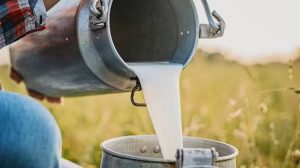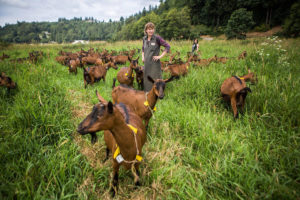The McClures have lived on the peninsula for four generations, longer than any ranching family on the point. But a number of factors—with drought at the top of the list—have pushed Mr. McClure to sell his herd of 650 cows and lay off his staff.
“I’m a dairy man to the core, but there’s another life out there—and I want to see it before I’m six feet under,” he told the Light this week.
The closure comes on the eve of the National Park Service amending the seashore’s general management plan to offer 20-year ranch leases, following six decades of short-term agreements. Mr. McClure said he plans to negotiate a lease to raise heifers in an operation that would be far smaller and gentler on the land. For now, he is keeping 150 young cows to graze.
Mr. McClure is 60 and none of his three daughters want to take on the business after him. He has had four eye surgeries that left him vulnerable to the wind and sun. He wants to travel and spend more time with his wife, Ruth, on their small ranch in Petaluma, where she works. But although these personal factors underlie his decision, he said the main reason for shutting down was the fear of running out of water.
The drought in Marin is the worst since 1977, and it has the potential to become the worst ever. Already, farmers are scaling back their crops or skipping the season altogether, and ranchers are making plans to truck in water and upgrade their collection systems. Only 15 inches of rain have fallen in Inverness this winter, the driest year on record. The winter before was not much better, with 23 inches of rain, compared to an average of 37.5 inches.
The McClure ranch relies on a single spring that is historically abundant but is no longer recharging. At this time of year, the water typically overflows into Abbotts Lagoon, but water levels are instead falling—and at least five months without significant rainfall lie ahead.
Mr. McClure shares a pond with the neighboring Kehoe dairy as a backup, but if and when that source were to run dry, both dairies would have to either move their herds or truck in water, an expensive proposition. The McClure dairy uses an estimated 20,000 gallons of water each day, mostly for the cows to drink but also to wash manure out of the barn.
The lack of rain causes the grass to grow slower, so the dairy must purchase more feed to nourish the cows. Feed prices are rising because farmers are also facing water restrictions.
Beyond the drought, the economics of dairying are not as strong as they once were, Mr. McClure said. He sells his milk to Clover Sonoma, and the company sets his production limits and price per gallon. Values are down 30 percent from their peak due to a glut of organic milk producers, he said.
Last month, he sold 80 of his cows to an out-of-state buyer that he declined to name. The buyer was pleased, and he offered to purchase the rest of the herd. At a time when people are struggling to sell organic cows, Mr. McClure was enticed by the offer. He sat down with his family and they all encouraged him to sell. The first load went out on Tuesday and the rest will go over the next two weeks.
Mr. McClure said he may hire help after he transitions out of dairying, but once the lactating cows are gone, his business will have no income, he said.
The consequences for the around 30 people who live on his ranch are enormous. The children attend local schools, and a few of the families have lived there for over 20 years. They have one month left of work and two months before they are expected to move out. No one knows what will come next.
“It’s like a really big bucket of cold water dumped on top of your head,” said Miguel Galarza, who has lived on the ranch with his wife and four kids for the last eight years.
Mr. McClure gathered his staff last week to break the news. He became emotional when he talked about that moment. “Super good guys,” he said. “Our success has always been from our employees.”
Jesus Romo has been the dairy foreman for the last 22 years. He starts each day at 6 a.m., checking the cows and giving marching orders. He enjoys the job because the weather is pleasant, Mr. McClure is a cheerful boss and the housing is relatively nice. When he told his two daughters that they were moving, he said they started crying.
“All of our lives were here,” he said. “This is part of my family.”
He said he has no choice but to move on and look for work at another dairy. “I don’t know how to do anything else but taking care of cows—cows are my life,” he said. “It’s sad to move and do it somewhere else, but we have to keep going.”
The displacement of families exposes the intrinsic problem with tying housing to employment. The last time this many West Marin families were displaced at once was when Drakes Bay Oyster Company closed in 2014; at that time, 32 mostly Hispanic men and women lost their jobs, and the 15 families who lived onsite had to move. The housing market has only become tighter and more expensive since then.
“Trying to find homes for eight families right now when there are very little vacancies, and the urgency of having to find a home when you’re worried about public health, is very concerning,” said Leelee Thomas, a planning manager for Marin County.
Rosa Rodriguez moved to Point Reyes two years ago from the Central Valley after her husband lost his job at another dairy. Her two older sons attend Tomales High, and the youngest goes to West Marin School. She appreciated being in an unpopulated area during the pandemic and is hoping the family can find another dairy close by, where her husband can keep milking cows and her children can stay in class.
“It could destroy our education. It’s very hard for someone to focus when a lot of things are happening,” she said. “We don’t have a lot of options. There aren’t a lot of jobs, or places to live.”
The future of the McClure ranch will depend on an upcoming appraisal and the park’s lease terms. The National Park Service will officially update its management plan by July, after which appraisers will determine a fair market rent for each ranch. Rental rates will account for activities occurring on the ranch, so Mr. McClure will likely pay less for a downsized operation.
“We look forward to working with the McClures to identify a transition approach on I Ranch consistent with the General Management Plan amendment,” outreach coordinator Melanie Gunn wrote in an email.
If Mr. McClure does not sign a lease, the park service would be guided by the succession policy outlined in the amendment. The policy says that if a rancher does not wish to enter into a new lease, the park would consider proposals from other leaseholders or ranch workers within the park. If none of them are interested in operating a ranch, then the park would pursue a public process to identify an appropriate future use of the land.
In recent years, the McClure ranch has become a target of anti-ranching and pro-elk activists; last fall, over 200 people staged a protest on the driveway. Mr. McClure didn’t have much to say on the matter; his dairy is not in the range of any elk herds. During the protest, he greeted them and observed.
Activist groups contracted water tests near his ranch this winter, and the tests showed bacteria levels that greatly exceeded recreational standards. But it was just two days of testing after rain, and credible water monitoring requires multiple tests over time to paint an accurate picture. No regular water monitoring has been conducted in the area since 2013, though the regional water board requires dairies to maintain records on manure application and storage, pasture and riparian conditions and more.
Mr. McClure said he complies with all of the rules. The cows go in the loafing barn during the winter to prevent manure from washing away, and the creek areas are fenced off, he said.
In his 38-year tenure, he remodeled the milking operation to make it more efficient and brought in new technology, like a no-till seed drill and automatic scrapers in the barns. Many of the improvements have been made to help conserve the environment, he said.
Even with the upgrades, the ranch retains its layout from the 1800s. Nine features predating 1925 are listed on the National Register of Historic Places, including the large hay barn built in the 1880s. From James to Jim to Ron and now Bob, the McClures have been milking cows on Point Reyes since 1889, when products traveled by schooner to San Francisco. James McClure bought his first dairy in 1906 and the family moved around to several ranches before leasing the I Ranch in 1930.











